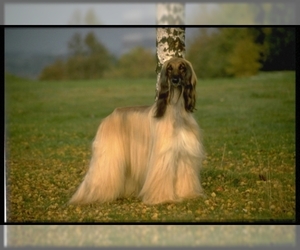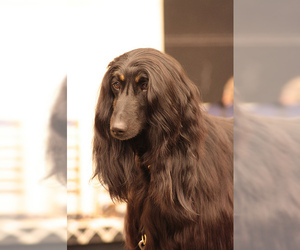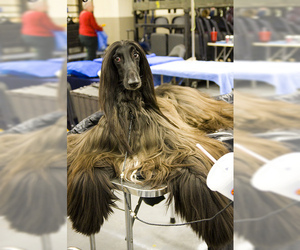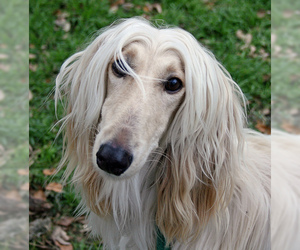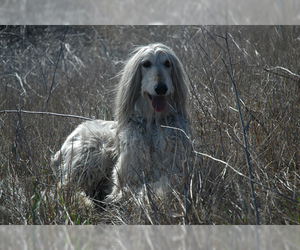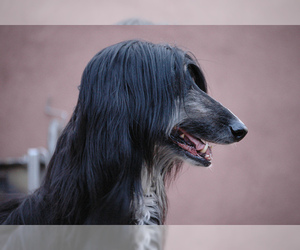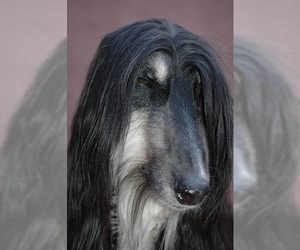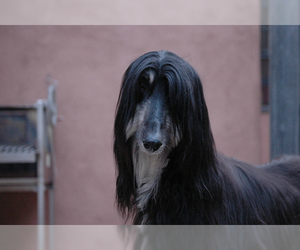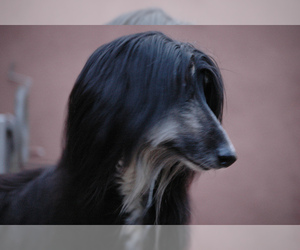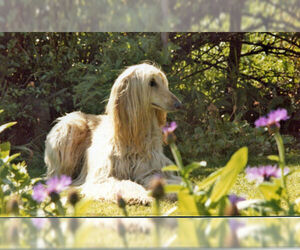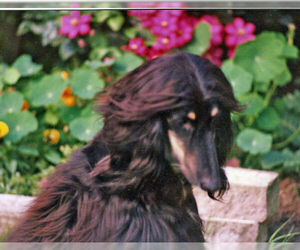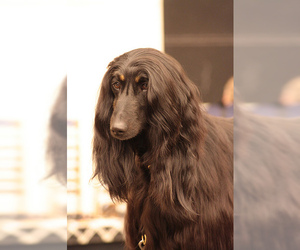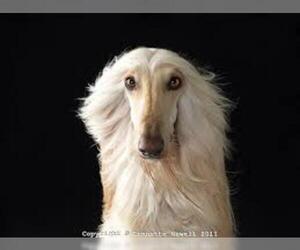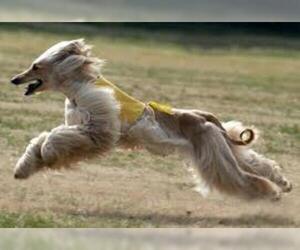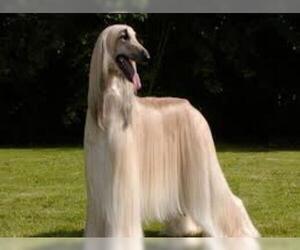
All about Afghan Hound dog breed
A.K.A. :Tāzī, Balkh Hound, Barutzy Hound, Baluchi Hound, Kabul Hound, Kurram Valley Hound, Galanday Hound, Shikari Hound, Ogar Afgan, Sage-Kabul, Sage Baluchi, Afghan, "The King of Dogs"
Size
Grooming requirements
Exercise requirements
Good with other dogs
Watchdog ability
Energetic
Training requirements
Playful
Affectionate
Good with other pets
Good with children
Good with strangers
Winter
Summer
Healthiness
Protective
Life Span
| Pure Breeds | Member |
| Breeds A - Z | A |
| Breeds by Group | Hound Sighthound & Pariah |
| Breeds by Trait | Fast Dog Breeds High Stamina Dog Breeds Low Shedding |
| Overview: | The majestic Afghan Hound, an ancient breed originating from the mountains of Afghanistan, is instantly recognizable by its striking appearance and flowing locks. Their most prominent physical characteristic is their long, silky coat, often requiring regular grooming to prevent matting, along with a distinctive "ring" tail and elegant, high-set ears. Beneath the glamorous exterior lies a temperament that is often described as independent and somewhat aloof, yet also affectionate with their families. While intelligent, they can be a challenge to train due to their strong prey drive and independent nature. They are generally not ideal for apartment living as they require ample space and regular exercise to satisfy their athletic build. While they can be good with respectful older children, their independence means they may not always be a boisterous playmate for younger ones. Regarding health, they are generally a robust breed, but some lines may be prone to hip and elbow dysplasia, as well as certain eye conditions. Potential owners should be prepared for a committed relationship with this unique and beautiful sighthound. |
F.A.Q.
All You Need to Know About the Afghan Hound Breed
The Afghan Hound is an ancient and aristocratic breed, originating from the mountains of Afghanistan, known for its striking beauty and independent spirit. These hounds are characterized by their long, silky coats, distinctive topknots, and elegant, athletic build, designed for speed and endurance. Temperamentally, the Afghan Hound is often described as aloof and dignified, yet can be affectionate with their families. They are not typically recommended for apartment living due to their high exercise needs and desire for space to run, although they can adapt with sufficient outdoor activity. Their luxurious coats require significant grooming – daily brushing is essential to prevent matting. While generally healthy, potential adopters should be aware of common health considerations such as hip and elbow dysplasia, and certain eye conditions. This intelligent but sometimes stubborn breed thrives with consistent training and makes a loyal companion for active individuals or families who appreciate their unique charm and can meet their specific care requirements.Afghan Hound Weight: Typically, the healthy weight for an adult Afghan Hound ranges from 50 to 60 pounds. While both males and females fall within this average size, males often lean towards the higher end of the range, showcasing their majestic build. This average Afghan Hound weight ensures they are well-proportioned for their characteristic grace and agility.
How tall is an Afghan Hound?
If you're wondering about the Afghan Hound height and average size, these majestic dogs typically stand between 25 to 27 inches (approximately 63.5 to 68.5 cm) at the shoulder. This measurement refers to their adult height, taken from the ground up to the highest point of their shoulder blades.While the overall range is quite consistent, you might observe slight variations. Generally, male Afghan Hounds tend to be at the higher end of this spectrum, often reaching the 27-inch mark, while females might be closer to 25 or 26 inches. However, individual genetics play a significant role, so it's not uncommon to find a slightly taller female or a slightly shorter male within the breed standard.So, if you're asking "how tall is an Afghan Hound?", expect a graceful and substantial dog, making them a noticeable presence in any home!Afghan Hounds exhibit a stunning range of Afghan Hound colors, from classic to truly exotic. The AKC recognized Afghan Hound colors include black, black and tan, cream, blue, domino, fawn, red, silver, and white. You'll also find brindle patterns and combinations like black cream, blue cream, red cream, and silver cream. Beyond these, rare coat types and exotic Afghan Hound variations can sometimes be found, though they are not accepted by major kennel clubs like the AKC. These may include chocolate, isabella/lilac, and merle patterns, which often arise from crosses with other breeds or specific genetic mutations. When considering Afghan Hound colors, it's important to note that AKC recognized Afghan Hound colors adhere to the breed standard, while rare coat types and exotic Afghan Hound variations might carry different pricing or health considerations.
The Afghan Hound personality is a unique blend of independent spirit and affectionate devotion. Known for their aristocratic appearance, their temperament of Afghan Hound is often described as aloof but deeply loyal to their family. They are generally friendly with people they know but can be reserved with strangers. While not overly clingy, they form strong bonds and appreciate being part of household activities.Friendliness & Sociability: They are typically friendly with their owners and familiar faces, but their natural dignity can make them seem cool or indifferent to new acquaintances. They aren't the type to eagerly greet every stranger.Loyalty: Afghan Hounds are extremely loyal to their families, often forming a special bond with one or two individuals. This loyalty translates into a protective instinct, though they are not primarily guard dogs.Adaptability to Apartment Living: While graceful and relatively calm indoors, their high energy levels and need for extensive exercise make apartment living challenging without dedicated daily walks and opportunities to run in a secure area. A house with a large, fenced yard is ideal.Behavior with Children: Their tolerance for children can vary. They are generally good with older, respectful children who understand how to interact with a dog. However, their independent nature and sensitivity mean they may not be the best choice for very young children who might be overly boisterous or pull on their long fur. Supervision is always recommended.Behavior with Other Pets: With proper socialization from a young age, they can coexist peacefully with other pets, especially other dogs. However, their strong prey drive, inherent to their sighthound lineage, means they may view smaller, fast-moving animals (like cats or small rodents) as prey. Careful introductions and management are essential if integrating them into a multi-pet household.
The Afghan Hound temperament is often described as aloof, regal, and independent. While incredibly loyal to their families, they are not typically effusive in their affections and can be reserved with strangers. This breed's personality traits include a dignified and sometimes playful nature, but they possess a strong hunting instinct. They are moderately adaptable to apartment living provided they receive ample daily exercise; a large, securely fenced yard is ideal for their running needs.
Regarding companion dog behavior, Afghan Hounds are generally good with older, respectful children who understand their boundaries. Their strong prey drive means careful introductions and supervision are necessary with smaller pets, though they can coexist peacefully with cats or other dogs if raised together. They can be stubborn and sensitive, requiring patient, consistent, positive reinforcement training methods. Their intelligence is high, but they are known for their independent thought, making them less inclined to blindly obey. Early socialization is crucial to foster a well-adjusted adult.Afghan Hound Care: Daily Maintenance & Health TipsAfghan Hound care requires consistent attention. Their glorious, flowing coat demands significant grooming needs. Expect daily brushing to prevent mats and tangles, with professional grooming every 4-6 weeks for bathing and trimming. Regular ear cleaning is essential to prevent infections, as their long, pendulous ears can trap moisture.Despite their elegant appearance, Afghan Hounds are a low-energy dog breed indoors, but require a minimum of one long, brisk walk or vigorous play session daily to burn off energy and maintain muscle tone. Due to their sighthound nature, a securely fenced yard is crucial.Dietary considerations should focus on high-quality dog food appropriate for their life stage. Weight management is vital as excess weight can strain their long backs and joints. Monitor calorie intake and avoid overfeeding.Common health tips for Afghan Hound owners include regular dental care to prevent periodontal disease. While not brachycephalic, their long snouts still require attention to breathing, and they can be sensitive to extreme climates, particularly heat due to their thick coats. Skin issues, including dry skin and allergies, can occur, so a balanced diet with omega fatty acids can be beneficial. Regular veterinary check-ups are essential for early detection of any health concerns.
The Afghan Hound activity level is a captivating blend of aristocratic grace and surprising athleticism. While they appear serene and regal, how active are Afghan Hound can be quite energetic when given the opportunity. They require a good amount of Afghan Hound exercise needs, typically around 60-90 minutes of vigorous activity daily, ideally split into two sessions. This can include long, brisk walks, jogging, or controlled off-leash running in a securely fenced area.Afghan Hounds are sighthounds, meaning they have an innate desire to chase. They excel in activities like lure coursing and enjoy open spaces where they can stretch their legs. Playtime for an Afghan Hound often involves chasing toys or engaging in short bursts of high-speed running. They are not typically inclined towards endless games of fetch but enjoy independent play and exploring.It's important to note the limitations due to their brachycephalic anatomy. Although less pronounced than some breeds, their long snouts can still make them susceptible to overheating, especially in warm weather or during intense exercise. Therefore, exercise should be carefully monitored, particularly during peak heat, and ample water should always be available.Afghan Hounds famously balance short bursts of energy with long periods of rest. After their exercise, they are content to lounge regally, often enjoying comfortable beds or soft carpets. They are generally suitable for active families who can commit to their daily exercise requirements. However, they can also adapt to low-energy households if those households are prepared to dedicate the necessary time and effort to ensure their hounds receive adequate stimulation outside of the home. They are not a breed that thrives on being sedentary for extended periods without proper outlets for their energy.
Breed Breakdown: What Experts Say About the Afghan Hound
I would rate the Afghan Hound's "Size" trait a 7 out of 10.While not in the giant category, Afghan Hounds are undeniably large dogs. Males typically stand between 27-29 inches at the shoulder and weigh 60-70 pounds, with females slightly smaller. Their lean but muscular build, combined with their long legs and flowing coat, gives them an imposing and elegant presence. Compared to most companion dog breeds, they are significantly larger than your average Labrador or Golden Retriever, and dwarf smaller breeds like Beagles or Corgis. This size means they are generally not well-suited for apartment living or households with significant space constraints, as they need room to stretch out and move. Their size also makes traveling with them more challenging than with a smaller dog, often requiring larger crates and more planning.
The Afghan Hound rates a 9 out of 10 for grooming requirements. This is a very high-maintenance breed, primarily due to their incredibly long, flowing, and silky double coat. While they are moderate rather than heavy shedder, their extensive hair is highly prone to tangles, mats, and picking up debris. They require daily brushing to prevent severe matting, which can be painful and lead to skin issues if neglected. Regular professional grooming appointments or extensive at-home bathing and drying are essential, often two to three hours of work every few weeks, to keep their coat clean and healthy. Additionally, their long ears need frequent cleaning to prevent infections, and nail trimming is crucial as their active lifestyle might not always wear them down sufficiently. Compared to most other companion dogs, the Afghan Hound demands a significantly higher level of dedicated and time-consuming grooming.
I would rate the Afghan Hound's "Exercise Requirements" at a 7 out of 10.While their elegant, almost regal appearance might suggest a more sedentary lifestyle, Afghan Hounds are sighthounds, bred for chasing down game over long distances. They possess a surprising amount of stamina and require a significant amount of daily exercise to remain healthy and mentally balanced. They are not a breed that thrives with minimal activity; rather, they demand structured routines. Daily long walks or runs are essential, and they particularly enjoy the opportunity to gallop in a secure, fenced area. Their high prey drive means off-leash exercise is generally only safe in very specific, controlled environments. They have a good tolerance for sustained movement and can be excellent companions for runners or hikers, though careful consideration should be given to hot weather due to their thick coats, not any respiratory limitations as they are not brachycephalic. While not typically seen in agility due to their independent nature and size, they are certainly capable of it from a physical standpoint. Without adequate exercise, they can become bored, destructive, and even prone to weight gain.
I would rate the Afghan Hound's "Watchdog Ability" as a 3 out of 10.While Afghan Hounds are known for their aristocratic demeanor and can be quite discerning, they are generally not bred or inclined to be effective watchdogs. Their independent nature often means they are less concerned with territorial defense and more focused on their own comfort and pursuits. They possess a high degree of aloofness, particularly with strangers, which can be mistaken for a deterrent, but it's more about their reserved personality than an active desire to protect. They might bark at a sudden, unfamiliar sound, but this is usually a general alert rather than a sustained warning or an attempt to deter. Their sighthound heritage makes them incredibly fast and agile, but their primary response to an unknown presence would likely be observation or even retreat, rather than confrontation. They are much more suited to being elegant, sometimes challenging, companions than providing meaningful early warnings or actively deterring intruders in a home environment.
I would rate the Afghan Hound's "Good with Other Dogs" trait a 6 out of 10.While not inherently aggressive, the Afghan Hound's independent nature and strong prey drive can make them a bit of a mixed bag in canine company. They often possess a dignified aloofness and may not be effusively dog-friendly upon first meeting unfamiliar dogs, sometimes appearing indifferent or even slightly standoffish. Their sighthound heritage means small, fast-moving dogs can inadvertently trigger their prey instinct, requiring careful management. With consistent and early socialization, however, many Afghan Hounds can coexist peacefully and even form strong bonds with other dogs in their household, especially if they are introduced thoughtfully and raised together. They generally adapt well to multi-dog households if the other dogs respect their personal space and don't overwhelm them with boisterous play. However, they may not thrive in environments with highly dominant or aggressive dogs, and careful introductions and ongoing supervision are often necessary to ensure peaceful coexistence, especially with dogs of differing energy levels or sizes. They require an owner who understands their breed-specific quirks and is committed to positive reinforcement and continued socialization to bring out their more sociable side.
I would rate the Afghan Hound's "Energetic" trait as a 7 out of 10.While their elegant appearance might suggest a more laid-back nature, Afghan Hounds are surprisingly athletic and possess a significant amount of energy, especially as younger dogs. They were originally bred for hunting and have a strong prey drive, which translates into a need for regular, vigorous exercise. They are capable of bursts of incredible speed and possess remarkable endurance, making them suitable for activities like lure coursing, long walks, and even jogging with an experienced owner. Their playfulness is often expressed through running and chasing. They require consistent physical stimulation to prevent boredom and destructive behaviors, far from being a couch potato breed. However, it's important to note that they are not brachycephalic. The Afghan Hound has a long, refined muzzle, which allows for excellent air intake and does not compromise their stamina or exercise tolerance in the way a flattened face would for breeds like pugs or bulldogs. Their deep chest and athletic build are designed for efficient breathing and sustained effort, allowing them to participate in strenuous outdoor activities with ease, provided they are properly conditioned and not over-exercised in extreme heat. While they can be calm indoors after sufficient exercise, their innate athleticism and need for activity firmly place them in the higher energy bracket compared to many companion breeds.
I would rate the Afghan Hound's "Training Requirements" at an 8.While not unintelligent, the Afghan Hound is notoriously independent and possesses a strong will. Their attention span can be fleeting, especially if something more interesting (like a distant squirrel) catches their eye. Responsiveness to commands often depends on their mood and perceived value of the request, rather than an inherent desire to please. This stubbornness makes consistent, patient training absolutely essential, and a lack of it will result in an unmanageable dog. Positive reinforcement is effective, but it needs to be high-value and delivered precisely to capture their attention and motivate them. This breed is definitely not beginner-friendly and requires an experienced handler who understands sighthound psychology, is prepared for a long-term commitment to structured routines, and possesses the unwavering patience to work through their independent nature. Without experienced handling, they can easily become a challenge.
I'd rate the Afghan Hound's "Playful" trait a 4 out of 10. While they aren't entirely devoid of play, they are certainly more laid-back than many other companion breeds. Their activity level tends to be more about bursts of speed during a run rather than sustained, interactive play. They might engage with toys for a short period, especially if it involves chasing, but their attention-seeking behavior isn't typically expressed through boisterous games. Their enthusiasm in daily life is more about dignified observation and a calm presence rather than constant invitations to play. They are naturally spirited in the sense of their independent and sometimes mischievous nature, but not in a way that translates to being highly energetic or consistently fun-loving in a typical dog-play sense. They prefer to play on their own terms and often for shorter durations compared to breeds known for their effusive, game-oriented personalities.
I would rate the Afghan Hound's "Affectionate" trait a 4 out of 10.While undoubtedly loyal to their family, Afghan Hounds are known for their independent and somewhat aloof nature. They certainly desire human companionship and form strong bonds, but their expression of affection is often understated. You won't typically find an Afghan Hound clambering into your lap for extended cuddling sessions or following you like a shadow from room to room. They appreciate being near their people, often settling for a spot on the floor nearby, but are rarely physically demonstrative in the way many other companion breeds are. They are sensitive to owner emotions in the sense that they notice and react, but not necessarily in a way that translates to overt attempts at comfort. They are more independent compared to most companion dogs, thriving on a respectful partnership rather than constant effusive affection. They are certainly not emotionally distant, but their love is expressed more subtly and on their own terms.
I would rate the Afghan Hound's "Good with Other Pets" trait as a 4 out of 10.While not inherently aggressive, Afghan Hounds possess a very strong prey drive, making them highly incompatible with smaller, non-canine pets like cats, rabbits, or birds. Their instinct is to chase and often catch, and it's extremely difficult to train this out of them. They were bred for hunting and their sight hound nature means anything moving quickly can trigger this instinct.Regarding other dogs, they can be more adaptable, especially if socialized from a young age. However, they are often aloof and independent rather than overtly sociable. They may tolerate other dogs but are not typically known for being boisterous playmates. Resource guarding can occur, particularly if not properly trained and managed, but it's not a defining characteristic compared to their prey drive.Coexisting peacefully with other animals in a multi-pet household will almost always require significant training, constant supervision, and careful management, especially if those other pets are small. For homes with cats or smaller animals, it's generally not recommended or presents a very high risk, even with extensive effort. They are not naturally sociable with all species and require specific, intensive intervention to attempt to mitigate their strong instincts.
The Afghan Hound rates a 4 out of 10 for "Good with Children."While not inherently aggressive, the Afghan Hound's temperament is often described as aloof and independent. They possess a dignified and somewhat reserved nature, which means they aren't typically inclined to engage in boisterous play with children. Their patience for loud noises, unpredictable movements, and frequent handling, especially from younger children, is generally low. They may tolerate gentle interaction but are more likely to withdraw or move away than to participate. They are not naturally gentle or overtly affectionate in the way that some other breeds are, and their tolerance for being tugged on or climbed over is minimal. This breed requires significant training and supervision to ensure a safe and harmonious environment, particularly with young children, and is best suited for families with older, respectful children who understand how to interact calmly with a dog.
I'd rate the Afghan Hound's "Good with Strangers" trait a 4.Afghan Hounds are generally reserved and somewhat aloof with unfamiliar adults. While not typically aggressive, they aren't naturally effusive or openly welcoming. They tend to observe strangers from a distance, often exhibiting a dignified disinterest rather than seeking attention or interaction. Socialization is crucial for them to be comfortable and tolerate strangers, as without it, they can become shy or even fearful. Barking at strangers is possible, often as an alert, but they are not typically known for excessive guarding. Their adaptability in public or guest-filled environments depends heavily on early and consistent exposure; otherwise, they may appear stressed or withdrawn. They definitely require training and extensive socialization from a young age to develop a comfortable, rather than merely tolerant, demeanor around strangers.
I would rate the Afghan Hound's "winter" tolerance as a 6. While their long, flowing double coat provides a decent amount of insulation, it's not as dense or coarse as breeds specifically adapted for extreme cold. They possess a lean body type with relatively low body fat, meaning they have less natural insulation compared to stockier breeds. Their large size helps them retain heat better than very small dogs, but they lack the substantial body mass of, say, a Newfoundland. Being a dolichocephalic breed (long-nosed), they don't face the respiratory challenges in cold air that brachycephalic breeds do.However, despite their beautiful coat, they are still susceptible to hypothermia in prolonged exposure to very low temperatures, especially if wet or inactive. They can enjoy outdoor activity in cold climates, but not for extended periods without close monitoring. Compared to many other companion dogs, they will require *some* special care during winter months. While they might tolerate a brisk walk in 20-30°F for a while, they are not a breed you'd leave outside for hours in freezing conditions. They'll appreciate a warm bed indoors, and a coat or sweater might be beneficial for very cold outings, particularly for older or less active individuals, to ensure they can safely and comfortably enjoy their time outdoors.
I would rate the Afghan Hound's "Summer" tolerance at a 4.While not brachycephalic, the Afghan Hound's dense, long coat, though fine in texture, acts as insulation and can significantly hinder their ability to dissipate heat efficiently. They are a sighthound breed, built for bursts of speed and endurance in cooler climates, not prolonged activity in high temperatures. Their lean body mass and relatively low body fat mean they can overheat quickly. They are at a moderate to high risk of heatstroke if overexercised or left in warm environments. During summer months, their outdoor activity levels need to be significantly reduced, especially during peak heat hours. Unlike many other companion dogs, Afghan Hounds require considerable special care in summer, including strict avoidance of midday sun, access to air conditioning, and a constant supply of fresh, cool water. Owners must be vigilant for signs of overheating, as their coat can mask early symptoms.
I would rate the Afghan Hound's "Healthiness" trait a 6 out of 10.While generally a robust breed with a decent life expectancy of 12-14 years, the Afghan Hound is not without its specific health vulnerabilities, preventing a higher score. They are susceptible to certain genetic predispositions, including hip and elbow dysplasia, though responsible breeding has made strides in reducing their prevalence. Eye conditions such as cataracts and progressive retinal atrophy are also concerns. Anesthetic sensitivity is a significant issue for the breed, requiring careful management during any surgical procedures. They can also experience certain types of cancer and bloat, a life-threatening condition. Compared to some more heavily brachycephalic or extremely giant breeds, they are not considered "high-maintenance" in terms of frequent, severe health crises, but their long coat requires significant grooming to prevent skin issues, which can indirectly impact health. Therefore, while not fragile, they are not entirely without breed-specific health challenges that require diligent attention from owners and breeders, placing them in the moderate health category.
I would rate the Afghan Hound's "Protective" trait at a 3.While Afghan Hounds are undeniably alert to their surroundings, their protective instincts are generally not very strong. They are known for their independent and somewhat aloof nature, even with their own families. This translates to a relatively low territorial drive and a tendency to observe rather than actively confront strangers. Their loyalty lies more in companionship than in an innate need to guard. They might bark at an unfamiliar sight or sound, making them a decent "doorbell" (watchdog) in the sense of alerting you, but they are highly unlikely to engage as a guard dog to meaningfully protect your household. Their delicate build and generally gentle temperament further reinforce that they are primarily companion animals, not protectors.
I would rate the Afghan Hound's "Life Span" trait as a 7.This places them in the average to slightly above-average category when compared to other companion dog breeds. While not reaching the exceptional longevity of some smaller breeds, their typical lifespan of 10 to 14 years is quite respectable for a large breed. They are not considered short-lived. Responsible breeding practices have generally aimed to mitigate genetic predispositions to serious life-shortening conditions, though they can be prone to certain cancers and bloat, which can unexpectedly cut a life short. However, with good nutrition, regular exercise, and attentive veterinary care, many Afghan Hounds enjoy a full and healthy life within their expected range.
Afghan Hound Dogs for adoptionSee all dogs for adoption
Afghan Hound BreedersSee all breeders
Similar Dog Breeds for Afghan Hound
Breed Mixes of Afghan Hound
Quick Breed Selector 0 - not important, 1 - smallest, 10 - largest
Variants & Mistakes :Afgan Hound, Afgan Hounds, Afgans Hounds, Afghan Houns, Afghan Houn, Afhgan Hound, Afhgan Hounds, Afghane Hound, Afghane Hounds, Affghan Hound, Affghan Hounds, Afghaan Hound, Afghaan Hounds, Afgan Houn, Afhan Hound, Afhan Hounds, Afhgan Houn, Afhgan Houns, Aghfan Hound, Aghfan Hounds, Aghfgan Hound, Aghfgan Hounds, Afghna Hound, Afghna Hounds, Afghaun Hound, Afghaun Hounds, Afgaan Hound, Afgaan Hounds, Afghane Houn, Afghane Houns, Afghana Hound, Afghana Hounds, Afghanh Hound, Afghanh Hounds, Afhgans Hound, Afhgans Hounds, Afghans Houn, Afghans Houns, Afghan Houndes, Afgahn Hound, Afgahn Hounds, Afgans Hound, Affgan Hound, Affgan Hounds, Affghans Hound, Affghans Hounds, Afgahn Houn, Afgahn Houns, Afghian Hound, Afghian Hounds
